Accrued Interest: A Comprehensive Guide to Understanding
VerifiedAdded on 2019/09/26
|6
|1665
|141
Report
AI Summary
This report provides a detailed explanation of accrued interest, a crucial concept in finance and accounting. It defines accrued interest as the interest that has been earned but not yet received by the lender or paid by the borrower. The report differentiates between accrued interest and regular interest, highlighting how it arises under accrual accounting and impacts financial statements. It offers practical examples, including calculations for both borrowers and lenders, and explains how accrued interest is classified as either a current asset or a current liability. The report covers the formula for accrued interest and discusses its representation in the income statement and balance sheet, making it a valuable resource for students and professionals seeking to understand this important financial concept. The document is contributed by a student to be published on the website Desklib. Desklib is a platform which provides all the necessary AI based study tools for students.
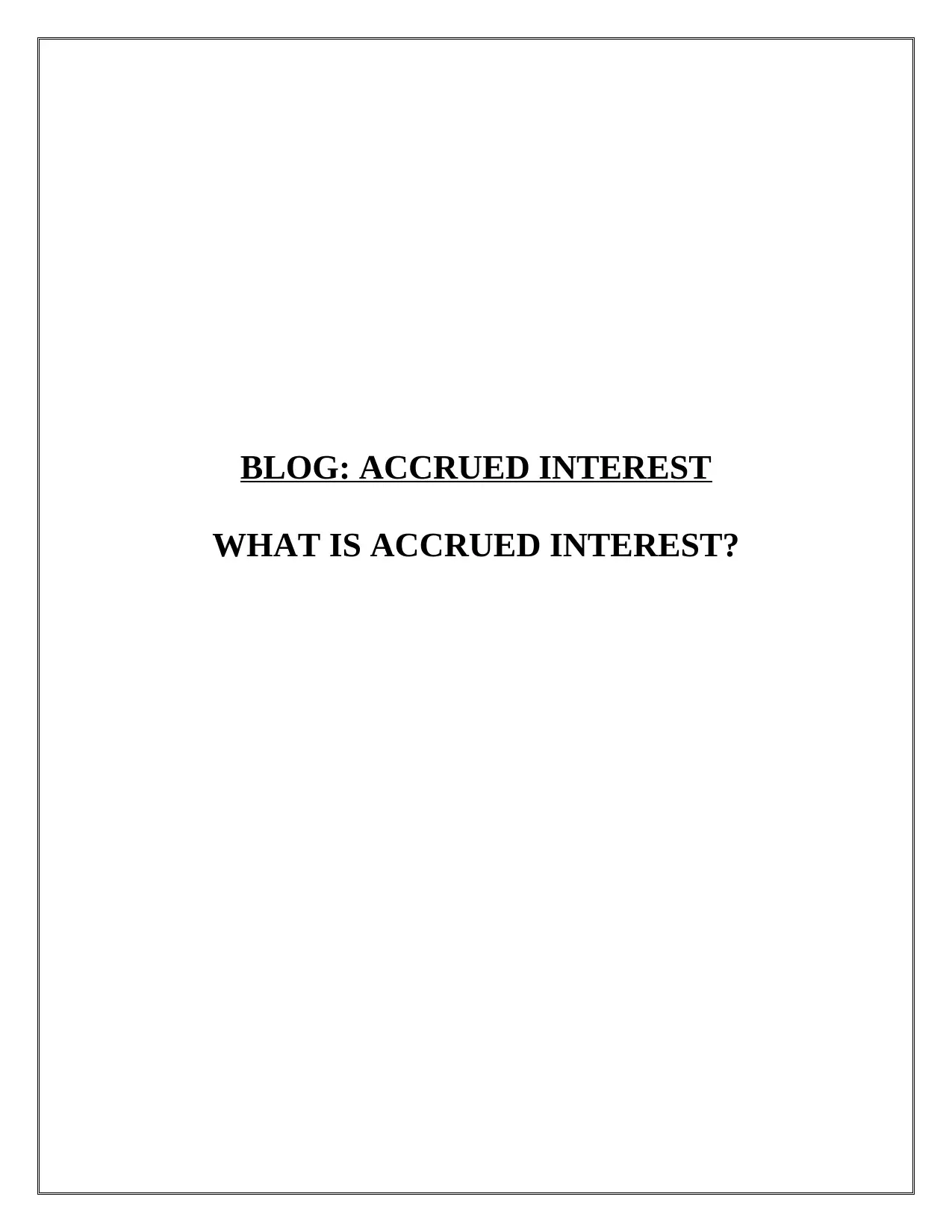
BLOG: ACCRUED INTEREST
WHAT IS ACCRUED INTEREST?
WHAT IS ACCRUED INTEREST?
Paraphrase This Document
Need a fresh take? Get an instant paraphrase of this document with our AI Paraphraser
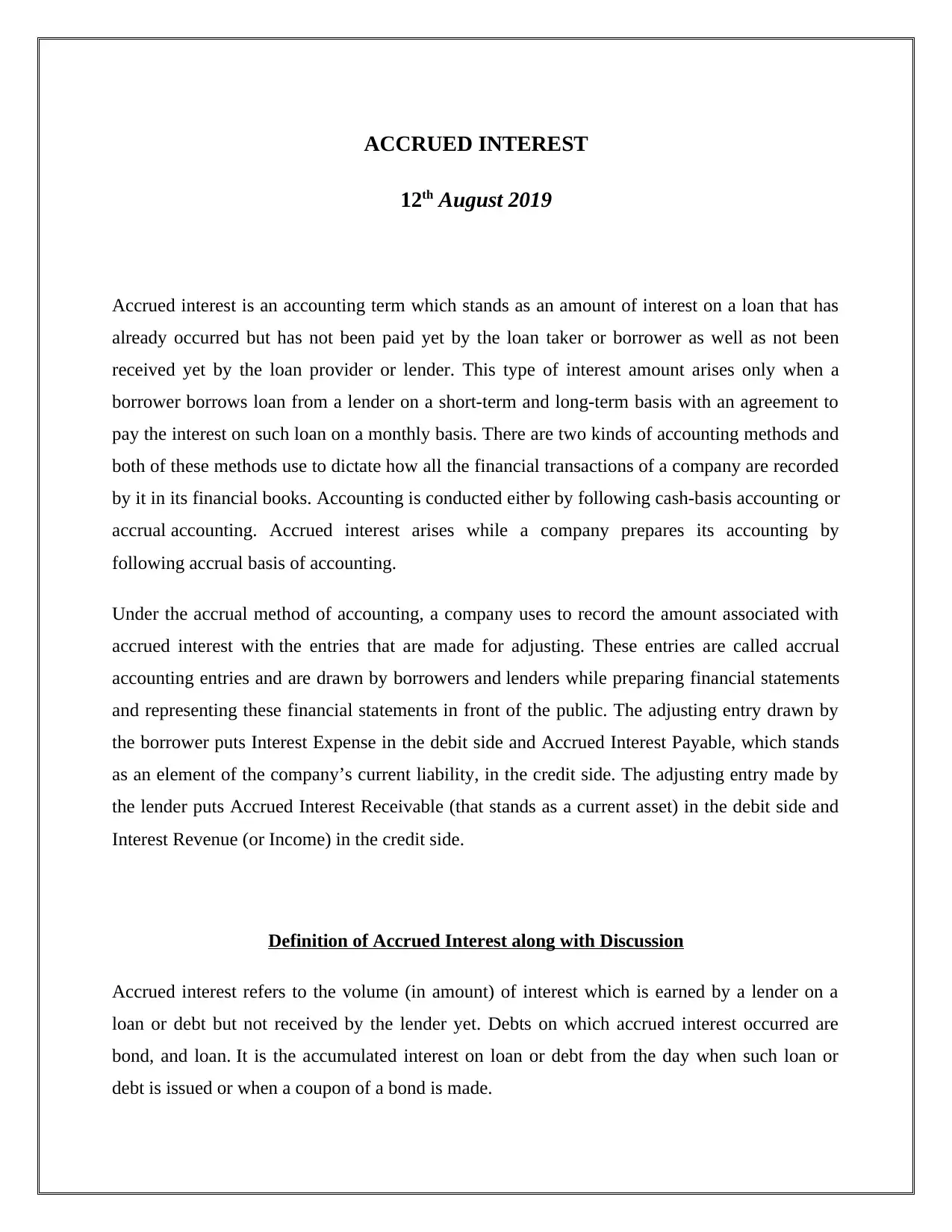
ACCRUED INTEREST
12th August 2019
Accrued interest is an accounting term which stands as an amount of interest on a loan that has
already occurred but has not been paid yet by the loan taker or borrower as well as not been
received yet by the loan provider or lender. This type of interest amount arises only when a
borrower borrows loan from a lender on a short-term and long-term basis with an agreement to
pay the interest on such loan on a monthly basis. There are two kinds of accounting methods and
both of these methods use to dictate how all the financial transactions of a company are recorded
by it in its financial books. Accounting is conducted either by following cash-basis accounting or
accrual accounting. Accrued interest arises while a company prepares its accounting by
following accrual basis of accounting.
Under the accrual method of accounting, a company uses to record the amount associated with
accrued interest with the entries that are made for adjusting. These entries are called accrual
accounting entries and are drawn by borrowers and lenders while preparing financial statements
and representing these financial statements in front of the public. The adjusting entry drawn by
the borrower puts Interest Expense in the debit side and Accrued Interest Payable, which stands
as an element of the company’s current liability, in the credit side. The adjusting entry made by
the lender puts Accrued Interest Receivable (that stands as a current asset) in the debit side and
Interest Revenue (or Income) in the credit side.
Definition of Accrued Interest along with Discussion
Accrued interest refers to the volume (in amount) of interest which is earned by a lender on a
loan or debt but not received by the lender yet. Debts on which accrued interest occurred are
bond, and loan. It is the accumulated interest on loan or debt from the day when such loan or
debt is issued or when a coupon of a bond is made.
12th August 2019
Accrued interest is an accounting term which stands as an amount of interest on a loan that has
already occurred but has not been paid yet by the loan taker or borrower as well as not been
received yet by the loan provider or lender. This type of interest amount arises only when a
borrower borrows loan from a lender on a short-term and long-term basis with an agreement to
pay the interest on such loan on a monthly basis. There are two kinds of accounting methods and
both of these methods use to dictate how all the financial transactions of a company are recorded
by it in its financial books. Accounting is conducted either by following cash-basis accounting or
accrual accounting. Accrued interest arises while a company prepares its accounting by
following accrual basis of accounting.
Under the accrual method of accounting, a company uses to record the amount associated with
accrued interest with the entries that are made for adjusting. These entries are called accrual
accounting entries and are drawn by borrowers and lenders while preparing financial statements
and representing these financial statements in front of the public. The adjusting entry drawn by
the borrower puts Interest Expense in the debit side and Accrued Interest Payable, which stands
as an element of the company’s current liability, in the credit side. The adjusting entry made by
the lender puts Accrued Interest Receivable (that stands as a current asset) in the debit side and
Interest Revenue (or Income) in the credit side.
Definition of Accrued Interest along with Discussion
Accrued interest refers to the volume (in amount) of interest which is earned by a lender on a
loan or debt but not received by the lender yet. Debts on which accrued interest occurred are
bond, and loan. It is the accumulated interest on loan or debt from the day when such loan or
debt is issued or when a coupon of a bond is made.
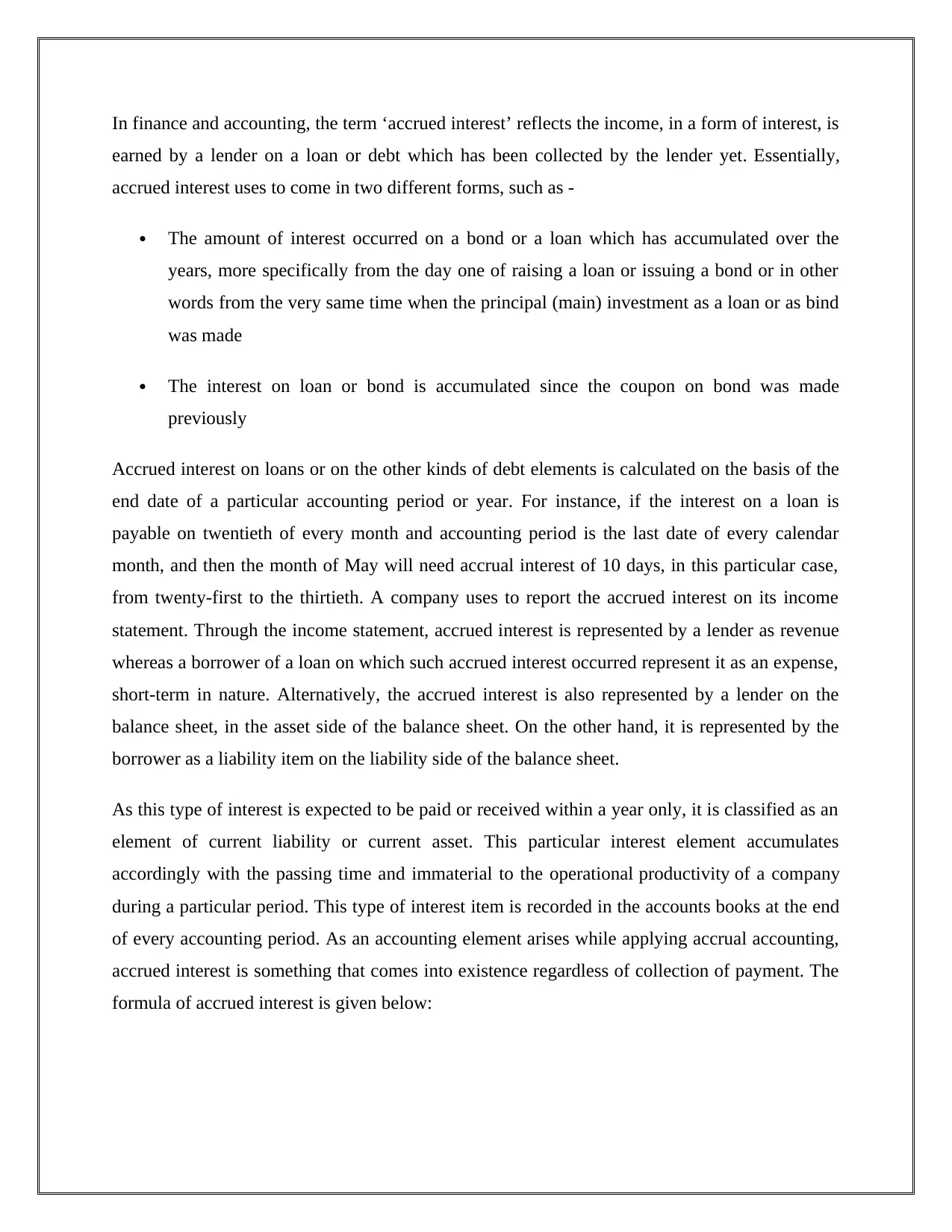
In finance and accounting, the term ‘accrued interest’ reflects the income, in a form of interest, is
earned by a lender on a loan or debt which has been collected by the lender yet. Essentially,
accrued interest uses to come in two different forms, such as -
The amount of interest occurred on a bond or a loan which has accumulated over the
years, more specifically from the day one of raising a loan or issuing a bond or in other
words from the very same time when the principal (main) investment as a loan or as bind
was made
The interest on loan or bond is accumulated since the coupon on bond was made
previously
Accrued interest on loans or on the other kinds of debt elements is calculated on the basis of the
end date of a particular accounting period or year. For instance, if the interest on a loan is
payable on twentieth of every month and accounting period is the last date of every calendar
month, and then the month of May will need accrual interest of 10 days, in this particular case,
from twenty-first to the thirtieth. A company uses to report the accrued interest on its income
statement. Through the income statement, accrued interest is represented by a lender as revenue
whereas a borrower of a loan on which such accrued interest occurred represent it as an expense,
short-term in nature. Alternatively, the accrued interest is also represented by a lender on the
balance sheet, in the asset side of the balance sheet. On the other hand, it is represented by the
borrower as a liability item on the liability side of the balance sheet.
As this type of interest is expected to be paid or received within a year only, it is classified as an
element of current liability or current asset. This particular interest element accumulates
accordingly with the passing time and immaterial to the operational productivity of a company
during a particular period. This type of interest item is recorded in the accounts books at the end
of every accounting period. As an accounting element arises while applying accrual accounting,
accrued interest is something that comes into existence regardless of collection of payment. The
formula of accrued interest is given below:
earned by a lender on a loan or debt which has been collected by the lender yet. Essentially,
accrued interest uses to come in two different forms, such as -
The amount of interest occurred on a bond or a loan which has accumulated over the
years, more specifically from the day one of raising a loan or issuing a bond or in other
words from the very same time when the principal (main) investment as a loan or as bind
was made
The interest on loan or bond is accumulated since the coupon on bond was made
previously
Accrued interest on loans or on the other kinds of debt elements is calculated on the basis of the
end date of a particular accounting period or year. For instance, if the interest on a loan is
payable on twentieth of every month and accounting period is the last date of every calendar
month, and then the month of May will need accrual interest of 10 days, in this particular case,
from twenty-first to the thirtieth. A company uses to report the accrued interest on its income
statement. Through the income statement, accrued interest is represented by a lender as revenue
whereas a borrower of a loan on which such accrued interest occurred represent it as an expense,
short-term in nature. Alternatively, the accrued interest is also represented by a lender on the
balance sheet, in the asset side of the balance sheet. On the other hand, it is represented by the
borrower as a liability item on the liability side of the balance sheet.
As this type of interest is expected to be paid or received within a year only, it is classified as an
element of current liability or current asset. This particular interest element accumulates
accordingly with the passing time and immaterial to the operational productivity of a company
during a particular period. This type of interest item is recorded in the accounts books at the end
of every accounting period. As an accounting element arises while applying accrual accounting,
accrued interest is something that comes into existence regardless of collection of payment. The
formula of accrued interest is given below:
⊘ This is a preview!⊘
Do you want full access?
Subscribe today to unlock all pages.

Trusted by 1+ million students worldwide
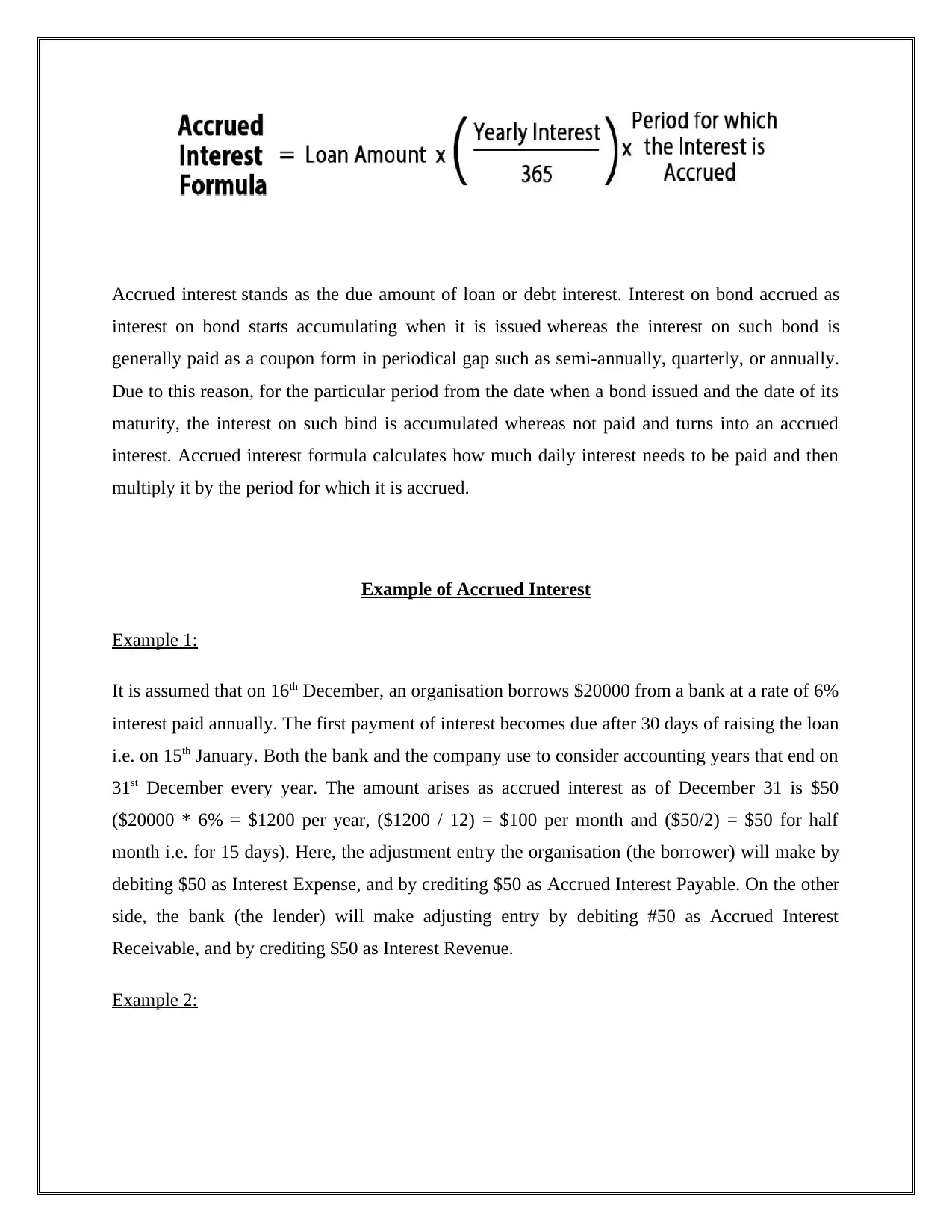
Accrued interest stands as the due amount of loan or debt interest. Interest on bond accrued as
interest on bond starts accumulating when it is issued whereas the interest on such bond is
generally paid as a coupon form in periodical gap such as semi-annually, quarterly, or annually.
Due to this reason, for the particular period from the date when a bond issued and the date of its
maturity, the interest on such bind is accumulated whereas not paid and turns into an accrued
interest. Accrued interest formula calculates how much daily interest needs to be paid and then
multiply it by the period for which it is accrued.
Example of Accrued Interest
Example 1:
It is assumed that on 16th December, an organisation borrows $20000 from a bank at a rate of 6%
interest paid annually. The first payment of interest becomes due after 30 days of raising the loan
i.e. on 15th January. Both the bank and the company use to consider accounting years that end on
31st December every year. The amount arises as accrued interest as of December 31 is $50
($20000 * 6% = $1200 per year, ($1200 / 12) = $100 per month and ($50/2) = $50 for half
month i.e. for 15 days). Here, the adjustment entry the organisation (the borrower) will make by
debiting $50 as Interest Expense, and by crediting $50 as Accrued Interest Payable. On the other
side, the bank (the lender) will make adjusting entry by debiting #50 as Accrued Interest
Receivable, and by crediting $50 as Interest Revenue.
Example 2:
interest on bond starts accumulating when it is issued whereas the interest on such bond is
generally paid as a coupon form in periodical gap such as semi-annually, quarterly, or annually.
Due to this reason, for the particular period from the date when a bond issued and the date of its
maturity, the interest on such bind is accumulated whereas not paid and turns into an accrued
interest. Accrued interest formula calculates how much daily interest needs to be paid and then
multiply it by the period for which it is accrued.
Example of Accrued Interest
Example 1:
It is assumed that on 16th December, an organisation borrows $20000 from a bank at a rate of 6%
interest paid annually. The first payment of interest becomes due after 30 days of raising the loan
i.e. on 15th January. Both the bank and the company use to consider accounting years that end on
31st December every year. The amount arises as accrued interest as of December 31 is $50
($20000 * 6% = $1200 per year, ($1200 / 12) = $100 per month and ($50/2) = $50 for half
month i.e. for 15 days). Here, the adjustment entry the organisation (the borrower) will make by
debiting $50 as Interest Expense, and by crediting $50 as Accrued Interest Payable. On the other
side, the bank (the lender) will make adjusting entry by debiting #50 as Accrued Interest
Receivable, and by crediting $50 as Interest Revenue.
Example 2:
Paraphrase This Document
Need a fresh take? Get an instant paraphrase of this document with our AI Paraphraser
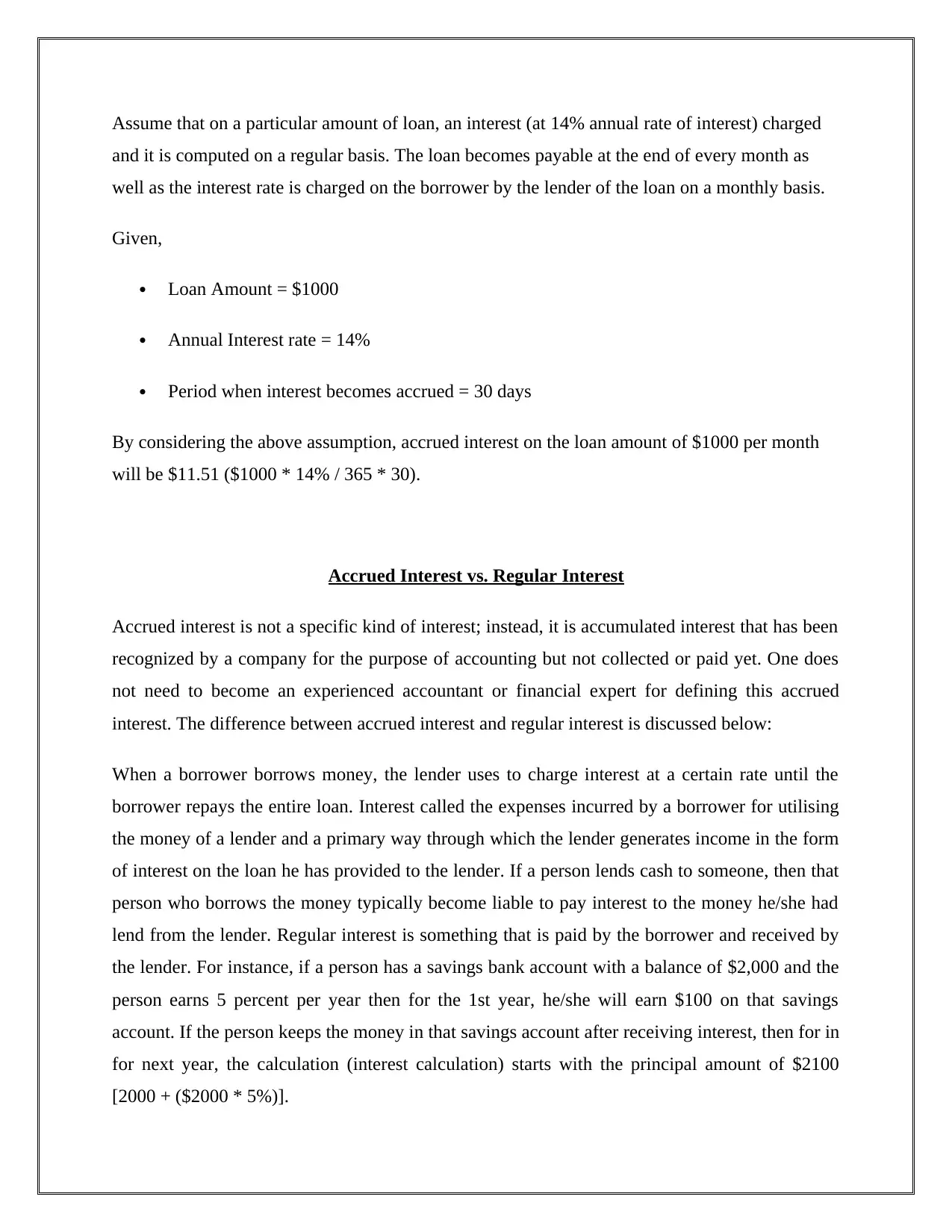
Assume that on a particular amount of loan, an interest (at 14% annual rate of interest) charged
and it is computed on a regular basis. The loan becomes payable at the end of every month as
well as the interest rate is charged on the borrower by the lender of the loan on a monthly basis.
Given,
Loan Amount = $1000
Annual Interest rate = 14%
Period when interest becomes accrued = 30 days
By considering the above assumption, accrued interest on the loan amount of $1000 per month
will be $11.51 ($1000 * 14% / 365 * 30).
Accrued Interest vs. Regular Interest
Accrued interest is not a specific kind of interest; instead, it is accumulated interest that has been
recognized by a company for the purpose of accounting but not collected or paid yet. One does
not need to become an experienced accountant or financial expert for defining this accrued
interest. The difference between accrued interest and regular interest is discussed below:
When a borrower borrows money, the lender uses to charge interest at a certain rate until the
borrower repays the entire loan. Interest called the expenses incurred by a borrower for utilising
the money of a lender and a primary way through which the lender generates income in the form
of interest on the loan he has provided to the lender. If a person lends cash to someone, then that
person who borrows the money typically become liable to pay interest to the money he/she had
lend from the lender. Regular interest is something that is paid by the borrower and received by
the lender. For instance, if a person has a savings bank account with a balance of $2,000 and the
person earns 5 percent per year then for the 1st year, he/she will earn $100 on that savings
account. If the person keeps the money in that savings account after receiving interest, then for in
for next year, the calculation (interest calculation) starts with the principal amount of $2100
[2000 + ($2000 * 5%)].
and it is computed on a regular basis. The loan becomes payable at the end of every month as
well as the interest rate is charged on the borrower by the lender of the loan on a monthly basis.
Given,
Loan Amount = $1000
Annual Interest rate = 14%
Period when interest becomes accrued = 30 days
By considering the above assumption, accrued interest on the loan amount of $1000 per month
will be $11.51 ($1000 * 14% / 365 * 30).
Accrued Interest vs. Regular Interest
Accrued interest is not a specific kind of interest; instead, it is accumulated interest that has been
recognized by a company for the purpose of accounting but not collected or paid yet. One does
not need to become an experienced accountant or financial expert for defining this accrued
interest. The difference between accrued interest and regular interest is discussed below:
When a borrower borrows money, the lender uses to charge interest at a certain rate until the
borrower repays the entire loan. Interest called the expenses incurred by a borrower for utilising
the money of a lender and a primary way through which the lender generates income in the form
of interest on the loan he has provided to the lender. If a person lends cash to someone, then that
person who borrows the money typically become liable to pay interest to the money he/she had
lend from the lender. Regular interest is something that is paid by the borrower and received by
the lender. For instance, if a person has a savings bank account with a balance of $2,000 and the
person earns 5 percent per year then for the 1st year, he/she will earn $100 on that savings
account. If the person keeps the money in that savings account after receiving interest, then for in
for next year, the calculation (interest calculation) starts with the principal amount of $2100
[2000 + ($2000 * 5%)].
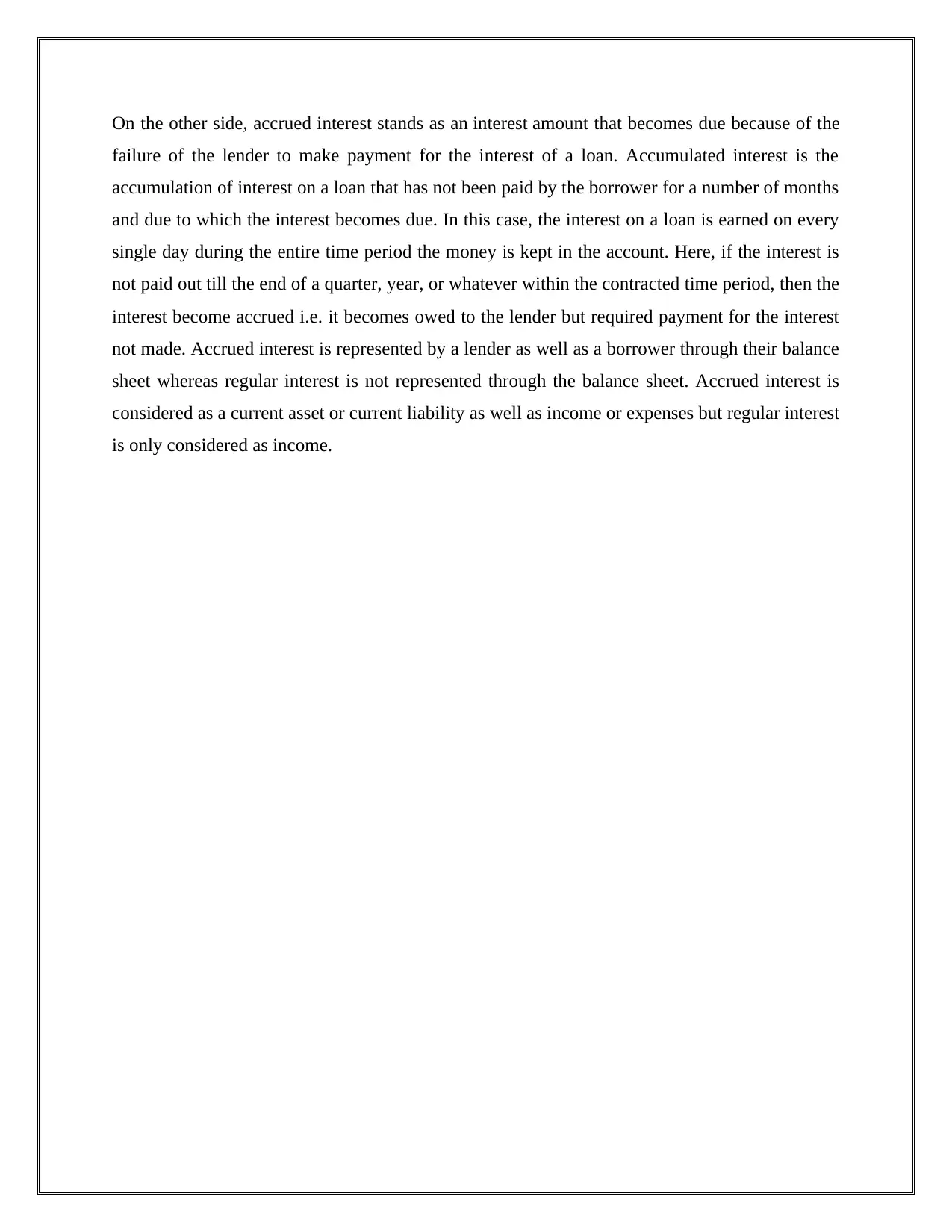
On the other side, accrued interest stands as an interest amount that becomes due because of the
failure of the lender to make payment for the interest of a loan. Accumulated interest is the
accumulation of interest on a loan that has not been paid by the borrower for a number of months
and due to which the interest becomes due. In this case, the interest on a loan is earned on every
single day during the entire time period the money is kept in the account. Here, if the interest is
not paid out till the end of a quarter, year, or whatever within the contracted time period, then the
interest become accrued i.e. it becomes owed to the lender but required payment for the interest
not made. Accrued interest is represented by a lender as well as a borrower through their balance
sheet whereas regular interest is not represented through the balance sheet. Accrued interest is
considered as a current asset or current liability as well as income or expenses but regular interest
is only considered as income.
failure of the lender to make payment for the interest of a loan. Accumulated interest is the
accumulation of interest on a loan that has not been paid by the borrower for a number of months
and due to which the interest becomes due. In this case, the interest on a loan is earned on every
single day during the entire time period the money is kept in the account. Here, if the interest is
not paid out till the end of a quarter, year, or whatever within the contracted time period, then the
interest become accrued i.e. it becomes owed to the lender but required payment for the interest
not made. Accrued interest is represented by a lender as well as a borrower through their balance
sheet whereas regular interest is not represented through the balance sheet. Accrued interest is
considered as a current asset or current liability as well as income or expenses but regular interest
is only considered as income.
⊘ This is a preview!⊘
Do you want full access?
Subscribe today to unlock all pages.

Trusted by 1+ million students worldwide
1 out of 6
Related Documents
Your All-in-One AI-Powered Toolkit for Academic Success.
+13062052269
info@desklib.com
Available 24*7 on WhatsApp / Email
![[object Object]](/_next/static/media/star-bottom.7253800d.svg)
Unlock your academic potential
Copyright © 2020–2025 A2Z Services. All Rights Reserved. Developed and managed by ZUCOL.





